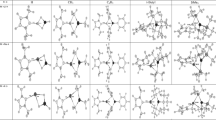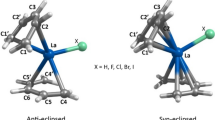Abstract
The reaction, electronic, molecular structures and bonding analysis of the haloalumylene substituted carbonyl complexes of the transition metal [TM(CO)3(AlX)] (TM = Group 10 metals; X = Halogens) were investigated at DFT/B3LYP/LANL2DZ/6-31G* level of theories. The charge distribution, orbital interaction between the transition metal (M) aluminium atom were analysed by NBO calculations. Energy dissociation analysis of the metal fragment and the haloalumylene fragment was studied. The feasibility of [TM(CO)3(AlX)] complexes were studied through five members coordinated transition state (TS).








Similar content being viewed by others
References
Dohmeier C, Loos D, Schnockel H (1996) Aluminum (I) and gallium (I) compounds: syntheses, structures, and reactions. Angew Chem Int Ed 35:129–149. https://doi.org/10.1002/anie.199601291
Schnepf A, Schnockel H (2002) Metalloid aluminium and gallium clusters: element modifications on the molecular scale? Angew Chem Int Ed 41:3532–3554. https://doi.org/10.1002/1521-3773(20021004)41:19%3C3532:AID-ANIE3532%3E3.0.CO;2-4
Koch K, Burgert R, Schnockel H (2007) From icosahedral boron subhalides to octahedral metalloid aluminum and gallium analogues: Quo Vadis, Wade’s rules? Angew Chem Int Ed 46:5795–5798. https://doi.org/10.1002/anie.200701020
Tacke M, Schnockel H (1989) metastable aluminium chloride, AlCl, as a solid and in solution. Inorg Chem 28:2895–2896. https://doi.org/10.1021/ic00313a039
Doriat CU, Friesen M, Baum E, Ecker A, Schnockel H (1997) Synthesis, structure, and oxidation of donor-stabilized gallium (I) Iodide Ga8I8.6Pet3**. Angew Chem Int Ed 36:1969–1971. https://doi.org/10.1002/anie.199719691
Mocker M, Robl C, Schnockel H (1994) Donor-stabilized aluminum(I) bromide**. Angew Chem Int Ed 33:1754–1755. https://doi.org/10.1002/anie.199417541
Ecker A, Schnockel H (1996) Donor stabilized aluminium (I) iodide *. Z Anorg Allg Chem 622:149–152. https://doi.org/10.1002/zaac.19966220120
Ecker A, Schnockel H (1998) Donor-stabilized aluminium iodides: a structural comparison. Z Anorg Allg Chem 624:813–816. https://doi.org/10.1002/(SICI)1521-3749(199805)624:5%3C813::AID-ZAAC813%3E3.0.CO;2-2
Ecker A, Koppe R, Uffing C, Schnockel H (1998) Reactions with aluminium (I) iodide. Z Anorg Allg Chem 624:817–822. https://doi.org/10.1002/(SICI)1521-3749(199805)624:5%3C817::AID-ZAAC817%3E3.0.CO;2-N
Klemm W, Voss E (1943) About a low aluminium fluoride. Z Anorg Allg Chem 251:233–240. https://doi.org/10.1002/zaac.19432510303
Hedderich HG, Dulick M, Bernath PF (1993) High-resolution emission spectroscopy of AlCl at 20 µ. J Chem Phys 99:8363–8370. https://doi.org/10.1063/1.465611
Ahlrichs R, Zhenyan L, Schnockel H (1984) On the structure of molecules (AlF)2, OAlF, and (OAlF)2 matrix IR studies and ab initio SCF calculations. Z Anorg Allg Chem 519:155–164. https://doi.org/10.1002/zaac.19845191216
Himmel H-J (2005) Characterization of Oligomers of AlCl: Al–Cl versus Al–Al Bonding. Eur J Inorg Chem. https://doi.org/10.1002/ejic.200401016
Liu LL, Zhou J, Cao LL, Stephan DW (2019) Phosphaaluminirenes: synthons for main group heterocycles. J Am Chem Soc 141:16971–16982
Weetman C, Bag P, Szilvási T, Jandl C, Inoue S (2019) CO2 fixation and catalytic reduction by a neutral aluminum double bond. Angew Chem 58:10961–10965
Hofmann A, Pranckevicius C, Tröster T, Braunschweig H (2019) Aluminium(I)/Boron(III) Redox Reactions. Angew Chem 58:3625–3629
Chu T, Korobkov I, Nikonov GI (2014) Oxidative addition of σ bonds to an Al(I) Center. J Am Chem Soc 136:9195–9202
Rudd PA, Liu S, Gagliardi L Jr, Young VG, Lu CC (2011) Metal–alane adducts with zero-valent nickel, cobalt, and iron. J Am Chem Soc 133:20724–20727
Bauer J, Braunschweig H, Damme A, Grus K, Radacki K (2011) Extending unsupported metal-only Lewis pairs to palladium. Chem Commun 47:12783–12787
Cui C, Roesky HW, Schmidt HG, Noltemeyer M, Hao H, Cimpoesu F (2000) Synthesis and structure of a monomeric aluminium(i) compound [{HC(CMeNAr)2}Al] (Ar = 2,6-iPr2C6H3): a stable aluminum analogue of a carbene. Angew Chem 39:4274–4276
Yadav R, Simler T, Goswami B, Schoo C, Köppe R, Dey S, Roesky PW (2020) Regioselective insertion of aluminium(I) in the cyclo-P5 ring of pentaphosphaferrocene. Angew Chem 59:9443–9447
Irngartinger H, Gries S (1991) Differenzelektronendichte in einem spiropenten. Angew Chem 103:595–596. https://doi.org/10.1002/ange.19911030528
Dohmeier C, Robl C, Tacke M, Schnöckel H (1991) The tetrameric aluminum(I) compound [{Al(η5-C5Me5)}4]. Angew Chem Int Ed 30:564–565. https://doi.org/10.1002/anie.199105641
Uhl W (1993) Organoelement compounds with Al-Al, Ga-Ga, and In-In Bonds. Angew Chem Int Ed 32:1386–1397. https://doi.org/10.1002/anie.199313861
Wehmschulte RJ, Ruhlandt-Senge K, Olmstead MM et al (1993) Reduction of a tetraaryldialane to generate Al-Al π-bonding. Inorg Chem 32:2983–2984. https://doi.org/10.1021/ic00066a002
Weiß J, Stetzkamp D, Nuber B et al (1997) [(η5-Cp*)Al-Fe(CO)4] – synthese, struktur, bindungsverhältnisse. Angew Chem 109:95–97. https://doi.org/10.1002/ange.19971090127
Schulte MM, Herdtweck E, Raudaschl-Sieber G, Fischer RA (1996) Transition metal stabilized AI~ and Ga[complexes; structure of [(CO)s Cr- Ga{(CH3)(tmeda)}]. Angew Chem Int Ed 35:424–426. https://doi.org/10.1002/anie.199604241
Fischer RA, Miehr A (1996) Comparative study of the metal-organic chemical vapour deposition of β-coga thin films from dialkylgallium tetracarbonylcobaltate single-source precursors. Chem Mater 8:497–508. https://doi.org/10.1021/cm9504044
Fischer RA, Miehr A, Schulte MM (1995) Bimetallic Fe/Ga thin films from single sources; molecular control of the thin film stoichiometry. Adv Mater 7:58–61. https://doi.org/10.1002/adma.19950070113
Fischer RA, Miehr A, Schulte MM, Herdtweck E (1995) First volatile alkylgallyl manganese complexes; structure of [(CO5)Mn]2Ga[(CH2)3NMe2]. Molecular control of the stoichiometry of Mn-Ga thin films grown by low-pressure MOCVD. J Chem Soc Chem Commun 300:337–338. https://doi.org/10.1039/C39950000337
Fischer RA, Miehr A, Priermeier T (1995) Transition-metal-substituted gallanes: synthesis and spectroscopic studies of highly polar σ(M-Ga) bonds, structures of trans-(Ph3P)(CO)3Co—Ga[(CH2)3N(C2H5)2]R (R = Cl, CH3) and (η5-C5H5)(CO)2Fe-GaCl2 [N(CH3)3]. Chem Ber 128:831–843. https://doi.org/10.1002/cber.19951280815
Fischer RA, Priermeier T (1994) Transition-metal-substituted alanes: synthesis and spectroscopic studies and the structure of (η5-C5H5)(CO)2Fe-M[(CH2)3NMe2](iBu). Organometallics 13:4306–4314. https://doi.org/10.1021/om00023a038
Braunschweig H, Müller J, Ganter B (1996) Molecular Structure of [CpFe(CO)2]AlAr (Ar = 2-[(Dimethylamino)methyl]phenyl): An Alanediyl Complex with Two Fe - Al Bonds. Inorg Chem 35:7443–7444. https://doi.org/10.1021/ic960471f
Fischer RA, Herdtweck E, Priermeier T (1994) Organoindium transition metal complexes. synthesis and reactivity. Structures of [(CO)4Co]2In[CH2Si(CH3)3](C4H8O), (ɳ5-C5H5)(CO)nM-In[(CH2)3N(CH3)2]2 (M = Fe, Ni; n = 2, 1), and (µ-CO){µ-In(CH2)3N(CH3)2}[(ɳ5-C5H5)(CO)Fe]2. Inorg Chem 33:934–943. https://doi.org/10.1021/ic00083a017
Ehlers AW, Dapprich S, Vyboishchikov SF, Frenking G (1996) Structure and bonding of the transition-metal carbonyl complexes M(CO)5L (M = Cr, Mo, W) and M(CO)3L (M = Ni, Pd, Pt; L = CO, SiO, CS, N2, NO+, CN-, NC-, HCCH, CCH2, CH2, CF2, H2). Organometallics 15:105–117. https://doi.org/10.1021/om950697a
Paularokiadoss F, Sekar A, Christopher Jeyakumar T (2020) A DFT study on structural and bonding analysis of transition-metal carbonyls with terminal haloborylene ligands [M(CO)3(BX)] (M = Ni, Pd, and Pt; X = F, Cl, Br, and I). Comput Theor Chem 1177:112750–112758. https://doi.org/10.1016/j.comptc.2020.112750
Paularokiadoss F, Sekar A, Christopher Jeyakumar T (2021) Coordination of indium monohalide with group-10 metal carbonyls [TM(CO)3(InX)]: a DFT study. Chem Pap 75:311–324. https://doi.org/10.1007/s11696-020-01319-7
Paularokiadoss F, Antony Sandosh T, Christopher Jeyakumar T, Sekar A (2021) Theoretical studies of group 10 metal gallylene complexes [TM(CO)3(GaX)]. Comput Theor Chem 1197:113139–113151. https://doi.org/10.1016/j.comptc.2020.113139
Pandey KK, Braunschweig H, Dewhurst RD (2011) DFT study on alkyl- and haloborylene complexes of manganese and rhenium: Structure and bonding energy analysis in [(ɳ5-C5H5)(CO)2M(BR)] and [(ɳ5-C5H5)(CO)2M(BX)] (M = Mn, Re; R = Me, Et, iPr, tBu; X = F, Cl, Br, I). Eur J Inorg Chem 2:2045–2056. https://doi.org/10.1002/ejic.201001200
Coombs ND, Clegg W, Thompson AL, Willock DJ, Aldridge S (2008) A Group 13/Group 17 Analogue of CO and N2: Coordinative Trapping of the GaI Molecule. J Am Chem Soc 130:5449–5451. https://doi.org/10.1021/ja800876k
Coombs ND, Vidovic D, Day JK, Thompson AL, Le Pevelen DD, Stasch A, Clegg W, Russo L, Male L, Hursthouse BM, Willock DL, Aldridge S (2008) Cationic terminal gallylene complexes by halide abstraction: coordination chemistry of a valence isoelectronic analogue of CO and N2. J Am Chem Soc 130:16111–16124. https://doi.org/10.1021/ja806655f
Peppe C, Tuck DG, Victoriano L (1982) Coordination compounds of indium. Part 40. Reactions of non-aqueous Solutions of Indium(I) Halides. J Chem Soc Dalton Trans 1:2165–2168. https://doi.org/10.1039/DT9820002165
Green SP, Jones C, Stasch A (2008) Synthesis and structural characterisation of soluble, metastable indium(I) halide complex, [InBr(tmeda)]. Chem Commun 1:6285–6287. https://doi.org/10.1039/B814658F
Becke AD (1988) Density-functional exchange-energy approximation with correct asymptotic behaviour. Phys Rev A: At Mol Opt Phys 38:3098–3100. https://doi.org/10.1103/PhysRevA.38.3098
Chiodo S, Russo N, Sicilia E (2006) LANL2DZ basis sets recontracted in the framework of density functional theory. J Chem Phys 125:104107–1-104107–8. https://doi.org/10.1063/1.2345197
Wadt WR, Hay PJ (1985) Ab initio effective core potentials for molecular calculations. Potentials for main group elements Na to Bi. J Chem Phys 82:284–298. https://doi.org/10.1063/1.448800
Hay PJ, Wadt WR (1985) Ab initio effective core potentials for molecular calculations. Potentials for K to Au including the outermost core orbitals. J Chem Phys 82:299–310. https://doi.org/10.1063/1.448975
Reed AE, Curtiss LA, Weinhold F (1988) Intermolecular Interactions from a Natural Bond Orbital, Donor-Acceptor Viewpoint. Chem Rev 88:899–926. https://doi.org/10.1021/cr00088a005
Reed AE, Weinstock RB, Weinhold F (1985) Natural population analysis. J Chem Phys 83:735–746. https://doi.org/10.1021/cr00088a005
Manoharan M, Venuvanalingam P (1997) AM1 and PM3 transition structures for the epoxidation of alkenes and allene by methylated dioxiranes. J Mol Struct (THEOCHEM) 394:41–47. https://doi.org/10.1016/S0166-1280(96)04899-3
Kavitha K, Venuvanalingam P (2002) 1,3-Dipolar additions involving allenes: a density functional study of concerted and stepwise mechanisms, J Chem Soc. Perkin Trans 2:2130–2139. https://doi.org/10.1039/B206470G
Jagadeesan R, Sabapathi G, Madhavan J, Venuvanalingam P (2018) Structure and reactivity of pd complexes in various oxidation states in identical ligand environments with reference to C−C and C−Cl coupling reactions: insights from density functional theory. Inorg Chem 57:6833–6846. https://doi.org/10.1021/acs.inorgchem.8b00239
Frisch MJ, Trucks GW, Schlegel HB, Scuseria GE, Robb MA, Cheeseman JR, Scalmani G, Barone V, Mennucci B, Petersson GA, Nakatsuji H, Caricato M, Li X, Hratchian HP, Izmaylov AF, Bloino J, Zheng G, Sonnenberg JL, Hada M, Ehara M, Toyota K, Fukuda R, Hasegawa J, Ishida M, Nakajima T, Honda Y, Kitao O, Nakai H, Vreven T, Jr. Peralta JE, Ogliaro F, Bearpark M, Heyd JJ, Brothers E, Kudin KN, Staroverov, Kobayashi R, Normand J, Raghavachari K, Rendell A, Burant JC, Iyengar, Tomasi J, Cossi M, Rega N, Millam JM, Klene M, Knox JE, Cross JB, Bakken V, Adamo C, Jaramillo J, Gomperts R, Stratmann RE, Yazyev O, Austin AJ, Cammi R, Pomelli C, Ochterski JW, Martin RL, Morokuma K, Zakrzewski VG, Voth GA, Salvador P, Dannenberg JJ, Dapprich S, Daniels AD, Farkas, Foresman JB, Ortiz JV, Cioslowski J, Fox DJ (2009) Gaussian 09, revision A.02; Gaussian Inc.: Wallingford, CT
Henderson TM, Janesko BG, Scuseria GE (2008) Generalized gradient approximation model exchange holes for range-separated hybrids. J Chem Phys 128:194105–1–194109. https://doi.org/10.1063/1.2921797
Maximoff SN, Ernzerhof M, Scuseria GE (2004) Current-dependent extension of the Perdew–Burke–Ernzerhof exchange-correlation functional. J Chem Phys 120:2105–2109. https://doi.org/10.1063/1.1634553
Van Lenthe E, Ehlers A, Baerends EJ (1999) Geometry optimizations in the zero order regular approximation for relativistic effects. J Chem Phys 110:8943–8953. https://doi.org/10.1063/1.478813
Bickelhaupt FM, Baerends EJ (2000) Kohn-Sham density functional theory: predicting and understanding chemistry. Rev Comput Chem 15:1–86. https://doi.org/10.1002/9780470125922.ch1
Frenking G, Wichmann K, Frohlich N, Loschen C, Lein M, Frunzke J, Rayon VM (2003) Towards a rigorously defined quantum chemical analysis of the chemical bond in donor–acceptor complexes. Coord Chem Rev 238–239:55–82. https://doi.org/10.1016/S0010-8545(02)00285-0
Author information
Authors and Affiliations
Corresponding authors
Ethics declarations
Conflict of interest
The authors declare that they have no known competing financial interests or personal relationships that could have appeared to influence the work reported in this paper.
Additional information
Publisher's Note
Springer Nature remains neutral with regard to jurisdictional claims in published maps and institutional affiliations.
Supplementary Information
Below is the link to the electronic supplementary material.
Rights and permissions
About this article
Cite this article
Sekar, A., Paularokiadoss, F., Immanuel, S. et al. Chemistry of group-10 metals monohaloalumylene complexes [TM(CO)3AlX]: a DFT study. Theor Chem Acc 140, 101 (2021). https://doi.org/10.1007/s00214-021-02801-5
Received:
Accepted:
Published:
DOI: https://doi.org/10.1007/s00214-021-02801-5




